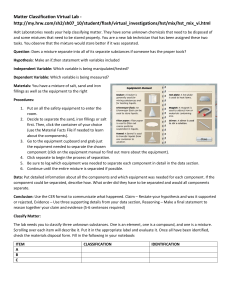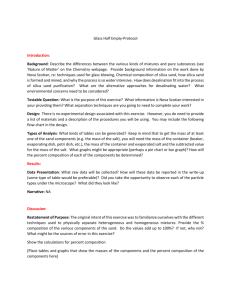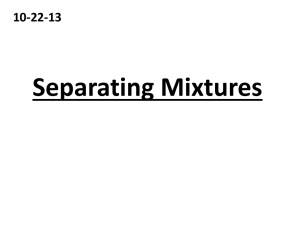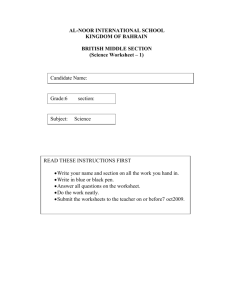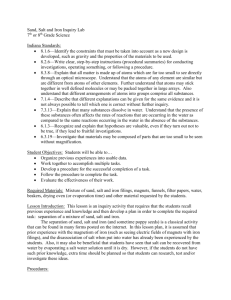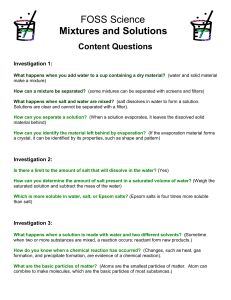Separation of Mixtures Zelda Smith Separated iron Equipment
advertisement
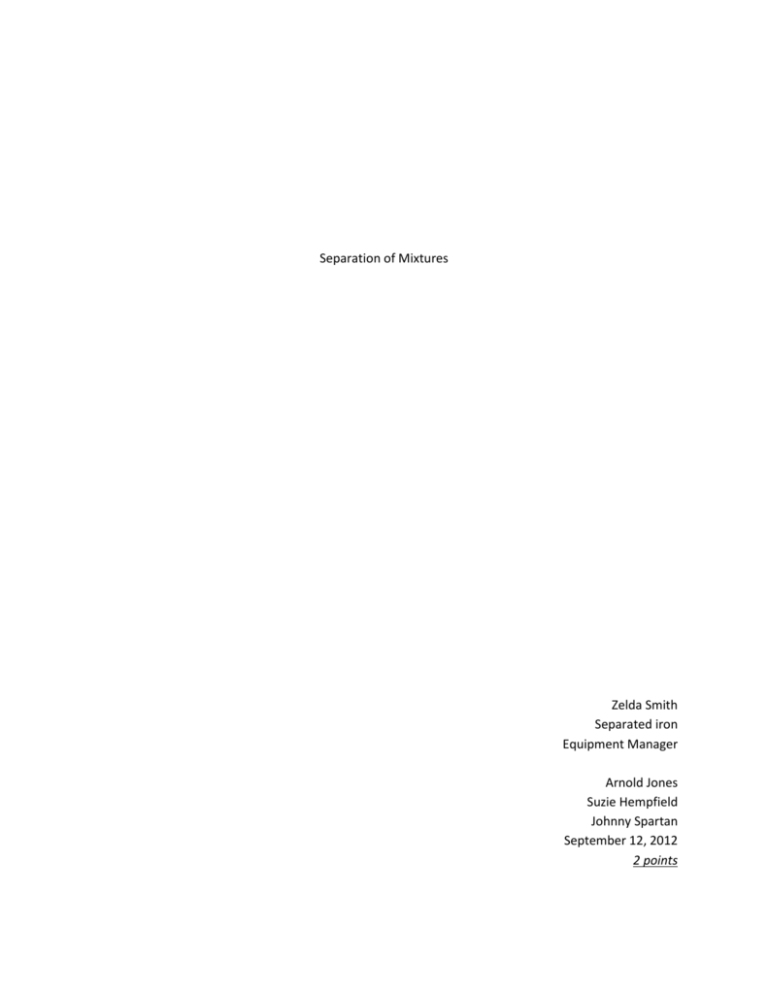
Separation of Mixtures Zelda Smith Separated iron Equipment Manager Arnold Jones Suzie Hempfield Johnny Spartan September 12, 2012 2 points Purpose: 2 points The purpose of this laboratory is to observe the physical properties of 4four substances (salt, sand, iron filings, and poppy seeds) and use the differences to separate a mixture of them. Procedure: 5 points The properties of magnetism, density, size, and solubility of salt, sand, iron filings, and poppy seeds were observed using magnets, water, and a magnifying glass. The differences were used to create a separation plan. A mixture of the substances was separated by using a magnet to remove the iron filings, shaking gently to separate and scoop out the poppy seeds, using water to dissolve the salt and float the remaining poppy seeds, and performing decantation and filtration to remove the sand. Safety precautions included the following. Goggles were worn and hands were washed at the end of the lab. Data: 5 points Observations of Substances: Properties Sand Dissolves Floats Magnetic Other (density) X (settles when shaken) Iron Filings Salt X Poppy Seeds X X X (settles when shaken) X (rises when shaken) Observations during separation: The iron filings separated easily. The poppy seeds sank as well as floated, causing added challenges! The salt dissolved as expected. The filtration process was very slow. Data Analysis: 5 points The success of each the separation of each substance on a scale of 1-10, 10 being best the worst is as follows: The iron filings earn a 1 because the magnetic separation was easy and complete. The sand earns a 3 because some was lost as it went through the filter and out with the decanted liquid. The poppy seeds earn a 9 because they unexpectedly sank and were very difficult to remove. The salt earned a 2 because it dissolved easily, but some sand came through with the water. Theory: 10 points The different physical properties of substances can be used to separate mixtures. A mixture is a blend of two or more kinds of matter, each of which retains its identity and properties. The properties may be used to separate a mixture. The physical properties useful for separation include melting point, boiling point, solubility, density, magnetism, size, color, weight, and shape. Chemical properties such as flammability and reactivity may also be used. The processes of separation include sorting, filtration, sieving, melting, distillation, evaporation, centrifugation, magnetism, decantation, and chromatography. Scientists and people in everyday life observe the properties and separate mixtures by taking advantage of the differences. For instance, in a plastics recycling plant the different types of plastic are separated by density. In an oil refinery, different boiling points are used to distill and separate different types of petroleum products in crude oil. In a hospital, blood cells are separated from serum using centrifugation. Conclusion: 8 points 1. The order of the steps was decided on by analyzing the observations logically. Any order would not have worked for this separation because if water had been added at the beginning, the magnet would not have separated the iron as well. 2. If I could do the lab over again, I would separate as many poppy seeds as I could before adding water because the seeds got very sticky in the water. 3. Two tools that would have made the separation easier are a sieve to separate the sand and poppy seeds and a source of heat to evaporate the water. 4. The iron was separated by its attraction to magnets, the poppy seeds were separated by density and size, the salt was separated because it dissolved in water, and the sand was separated by density and the fact that it does not dissolve in water. 2. The following two-part mixtures could be separated in the following ways: a. Aluminum and iron filings may be separated with a magnet. b. Sand and gravel may be separated by sieving. c. Sand and polystyrene may be separated by mixing in water and allowing the sand to sink and the foam to float. d. Salt and sugar may be separated by mixing in alcohol because the sugar will dissolve and the salt won’t. e. Alcohol and water may be separated by distillation. f. Nitrogen and oxygen may be separated by distillation or condensation at very low temperatures. 3. Salt was solid at the beginning of the experiment and dissolved in water at the end of this experiment. It can be converted to its starting form by allowing the water to evaporate. Sentences and format: 3 points


